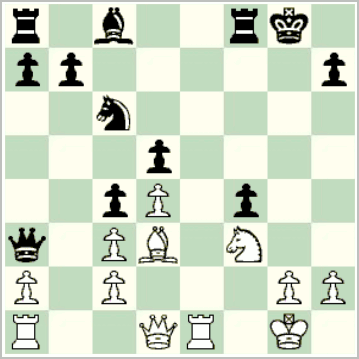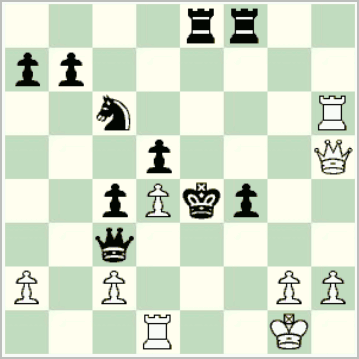Steffen Slumstrup Nielsen is the current World Champion of Study Composition, and co-author, with Jacob Aagaard, of the freshly published book Endgame Labyrinths.
He also has an account on X (formerly Twitter) that features many interesting studies and other curiosities. This week he posted a candidate for the greatest escape of all time, Berger – Ewin, Giessen Open 1993, which is well worth playing through.
He followed with a game of Irish interest, Heidenfeld – Roele, from Utrecht Amsterdam 1954.

16. ?
From the first diagram, play continued 16. Bxh7+ Kxh7 17. Ng5+ Kg6 18. Ne6 Bxe6 19. Rxe6+, and the king was inexorably drawn forward: 19… Kf5 20. Rh6 Qxc3 21. Qh5+ Ke4 22. Rd1 Rae8 (second diagram) 23. Qg6+ Ke3 24. Rh3+ f3 25. Rxf3+ Ke2 26. Rxc3 Kxd1.

23. ?
Black had lost his queen, but the worst was over. Heidenfeld’s later comment that it was Black who had winning chances is an exaggeration: White was still better at the end of this sequence. As so often, though, it was difficult for Heidenfeld to switch gears and win the game anew, and in the end he lost.
Background for this game, the event, and Heidenfeld’s little-known opponent, is given in an interesting post “Migrating South” by Tim Krabbé at Chess Curiosities, along with another game from the match.
This game, though not the other from the match, was already in the ICU games archive, though not here. It seems to have been added by Tim Harding in a draft update to the ICU archive in early 2016.
[Click to replay the full game.]
No annotations are given. Where, if anywhere, did White go wrong?
Update, October 14, 2023: the comments on this game at ChessGames.com say, plausibly, that Roele died in 2012, instead of the end suggested by Krabbé. His first names are variously given as Charles H. and Coenraad Hermanus. He played as Charles Roele in Munich 1942, the purported purported first European Individual Championship, not generally recognised as it was organised by Nazi Germany.
The questions of what the correct evaluation of the first diagram above and White’s best continuation from the second diagram are interesting exercises. The link above shows the game with no annotations, but here is another version with some notes.
Update, October 15, 2023: David McAlister points out that the game appeared in Heidenfeld’s book Chess Springbok (Cape Town, 1955) and provided the relevant pages, plus several analytical suggestions, for which many thanks. The game is also featured by Edward Winter in Chess Notes 11671 (13 January 2020), who surveys many references, and provides a link to analysis by Allan Beardsworth of the second diagram below. Among other comments, Winter corrects the site of the game; the post has been modified acordingly. The annotated version has been slightly updated for now; a fuller version may be added later.
